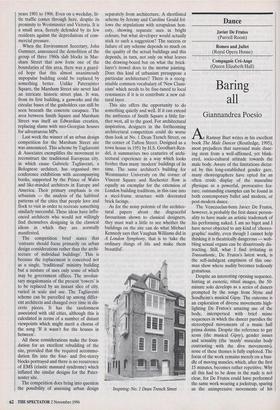Dance
Javier De Frutos (Purcell Room) Romeo and Juliet (Royal Opera House)
Compagnie Cre-Ange (Queen Elizabeth Hall)
Baring all
Giannandrea Poesio
ARamsay Burt writes in his excellent book The Male Dancer (Routledge, 1995), most prejudices that surround male danc- ing stem from a well-affirmed, yet blink- ered, socio-cultural attitude towards the male body. Aware of the limitations dictat- ed by this long-established gender gaze, many choreographers have opted for an often crude display of the masculine 1hysique as a powerful, provocative fea- ture; outstanding examples can be found in both contemporary ballet and modem, or post-modern dance.
The Venezuelan-born Javier De Frutos, however, is probably the first dance person- ality to have made an artistic trademark of his performing naked. I am no bigot and I have never objected to any kind of 'choreo- graphic' nudity, even though I cannot help thinking it is theatrically dangerous — wob- bling sexual organs can be disastrously dis- tracting. Still, what I find irritating in Transatlantic, De Frutos's latest work, is the self-indulgent emptiness of this one- man show where nudity becomes tediously gratuitous.
Despite an interesting opening sequence, hinting at esoteric, ritual images, the 50- minute solo develops as a series of dances prompted by the songs from Stync and Sondheim's musical Gipsy. The outcome is an exploration of diverse movements high- lighting De Frutos's amazing use of the body, interspersed with brief mime sequences in which the dancer parodies the stereotyped movements of a music hall prima donna. Despite the reference to gay icons (the musical Gipsy), gender issues and sexuality (the 'manly' muscular body contrasting with the diva movements), none of these themes is fully explored. The focus of the work remains merely on a bun- dle of moving muscles, which, after the first 15 minutes, becomes rather repetitive. Why all this had to be done in the nude is not clear, for De Frutos could have performed the same work wearing a jockstrap, sparing us the unimpressive movements of his
penis. But, then, how many people would have flocked to this performance had he not been naked?
Controversial as it might be, the balletic representation of masculinity has never been a problem in Kenneth MacMillan's works. His Romeo and Juliet is probably the best example: the powerful choreographic construction confers a straightforward, unambiguous characterisation on each male role. I have to admit that I am posi- tively biased towards this ballet, for it was the 1966 Royal Ballet performance of MacMillan's Romeo in Florence — starring Margot Fonteyn and Rudolph Nureycv that made me a dance devotee. Unlike other productions which have dated, MacMillan's, created in 1965, stands out for its up-to-date accessibility and immortal adaptability to diverse cultural epochs.
The opening night of the current run of performances highlighted these character- istics, stressing the wide range of interpre- tative choices this choreography offers. Miyako Yoshida might not be everyone's ideal Juliet — as an eminent colleague of mine, whose opinion I treasure, remarked during the interval. Still, I found her less unorthodox than I expected and I cannot help praising the way she approached the drama of this difficult role. Indeed, she is stronger in the first act than in the third one, where the technical demands of the part are superseded by silent acting, but her tenuous, yet vibrant coloratura of the part is everything but disappointing.
Similarly, Irek Mukhamedov is not a standard Romeo, although an interesting one. Mature, rather bullish at the begin- ning, he then becomes extraordinarily ten- der and passionate in the two great love duets. The only thing I criticise him for is his acting in the choral scenes which tends to go slightly over the top. Stuart Cassidy as Mercutio and Ashley Page as Tybalt also provided an interesting reading of their roles. The former changed the usually lack- adaisical daydreamer into a confident dare- devil, while the latter turned the macho Tybalt into an excruciatingly impetuous spoilt brat.
The week concluded with a performance of Squares by the Compagnie Cre-Ange at the Queen Elizabeth Hall, a work that reit- erates the modes and the trends of contem- porary French dance. Based on the interaction between a spoken text and a geometrical choreographic exploration of movement, space and music, the dance addresses different issues (lack of identity, racial themes, gender politics) through a series of apparently disjointed energetic images. Despite some less interesting movements, both the dancing and the cho- sen movement vocabulary are superb. It is with this kind of work that one can under- stand how much — like it or not — Euro- pean dance has evolved from a distinctive reaction to the established choreographic culture — namely ballet — instead of it being merely a secondary alternative.



















































































 Previous page
Previous page